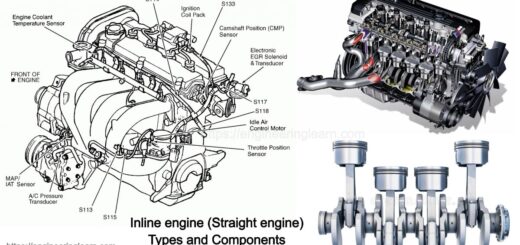Braking System Types and Function [Complete Guide]

What is Braking System?
Braking System Types and Function :- The braking system uses friction on both the sides of the wheel which is collectively pressed on the wheel which converts the kinetic energy of a moving vehicle into heat. For instance, braking much of energy to electrical energy can be stored for later use. The Eddy current braking system is that which uses the magnetic fields in order to turn the kinetic energy into an electrical current in the brake disc, blade and rail which is then finally converted into heat.
Types of Braking System
Here are some of the most common types of braking systems which are used in the modern cars. It is always good to know the perfect one that fit in your vehicle easily.
1. Hydraulic Braking System: ( Types of Braking System )
This braking system works on complete brake fluid, cylinders and friction by creating the impact of pressure within, glycol ethers or di-ethylene glycol which forces the brake pads in order to stop the wheels from moving.
The force which is produced in any hydraulic braking system is quite high as compared to the mechanical braking system. The hydraulic braking system is considered as one of the most important braking systems which is used in modern vehicles. Being a high quality breaking system, the chances of brake failure in such braking systems is very less. There is a direct connection within the actuator and the brake disc or drum which does not easily cause the chances of brake failure.
It is named as a hydraulic braking system, as the hydraulics refers to as the usage of liquid under pressure in order to:
- Transfer the effect of force or motion or in order to increase the effect of applied force.
- The effect of pressure on a liquid is referred to as a hydraulic pressure.
- The brakes which are operated by the help of a hydraulic pressure are known as hydraulic brakes.
- This braking system is based on the principle of the Pascal’s law.
Merits of Hydraulic Braking System
- Equal effect of braking at all the four wheels.
- Less rate of wear and tear because of the absence of joints as compared to mechanical brakes.
- The multiplication or division of forces is very easy by simply changing the size of the piston and cylinder compared to other.
Demerits of Hydraulic Braking System
It is important to know the demerits of Hydraulic braking system which are as follows:
- The breaking system becomes useless in case of slight leakage of air into it.
- The brake shoes can get ruined in case the brake fluid leaks out.
2. Electromagnetic Braking System: ( Types of Braking System )
The Electromagnetic braking systems is mostly found in various modern and hybrid vehicles. This braking system uses the principle of electromagnetism in order to achieve the frictionless braking which serves to increase the life span and reliability of the braking system.
The traditional braking systems are found slipping which was backed up with these quick magnetic brakes. So this technology is preferred without indulging friction or lubrication in the hybrid vehicles. Also, it is modern in size as compared to the traditional braking systems which is commonly used in trains.
To ensure the proper working of the electromagnetic brakes, a magnetic flux is passed in a perpendicular direction with respect to the rotating direction of the wheel. There is a rapid current flowing which is observed in the opposite direction to the rotation of the wheel. This develops an opposing force to the rotation of the wheel which slows the wheel down.
Advantages of Electromagnetic Braking System
- Electromagnetic braking system is quick and economical.
- Less maintenance cost for instance, replacing brake shoes periodically.
- Slight part of the energy is supplied for the continuous movement so that the running cost is reduced.
- A very slight amount of heat is generated in the electromagnetic breaking whereas in the mechanical braking high amount of heat is produced at the brake shoes which leads to a brake failure.
3. Frictional Braking System: ( Types of Braking System )
Frictional brakes are referred to as one of the most common breaking system which can be divided broadly into “shoe” or “pad” brakes, by using an explicit wear surface or a hydrodynamic braking system like parachutes, which work with the help of friction and its working fluid does not let explicit wear and tear.
The term friction brake is very commonly used to denote the pad or shoe brakes which excludes the hydrodynamic brakes although the hydrodynamic brakes cannot work without friction. Friction brakes work like the rotating devices with a stationary pad or a rotating wear surface which includes some common configurations like shoes which contract to rub outside the rotating drum like a band brake. The Murphy brake pinches a rotating drum and the disc brake uses a hollow disc with the shoes which sits between the disc surfaces and expands laterally.
4. Drum Braking System: ( Types of Braking System )
A drum brake is referred to that brake system in which the friction is caused due to the impact of a set of brake shoes which is pressed against the inner surface of a rotating drum. The drum is directly connected to the rotating road wheel hub so that it can work efficiently.
A rotating drum with a pair of shoes which expands to rub inside the drum is commonly known as a drum brake. A drum brake refers to that traditional break wherein the friction is caused by a set of shoes or pads which is pressed against the rotating drum that is shaped part and is known as a brake drum.
The term drum brake means that brake wherein the shoes press on the inner surface of the drum and the drum is pinched within the two shoes as similar to the standard disk brake. This is sometimes also referred to as a pinch drum brake whereas such brakes are comparatively quite rare.
5. Servo Braking System: ( Types of Braking System )
This braking system is also referred to as a vacuum or vacuum-assisted braking system. Within this system, the applied pressure increases which is put on the pedal by the driver. The mechanism uses a vacuum which is produced in the petrol engines by the intake of the air system in the intake pipe of engine or through the vacuum pump in a diesel engine. This braking system is used there where there is a power assistance and is used to reduce the efforts of human.
In a car the vacuum engine is mostly used to create a large diaphragm flex in order to operate the control of cylinder. Servo braking system boosters are the ones which are used in a combination with the hydraulic brake system. Vacuum boosters are mostly used at they increase the force of braking. Pushing the pedal of the brake releases the vacuum on the side of the booster and the difference in the air pressure which is created pushes the diaphragm for braking the wheel.
6. Mechanical Braking System: ( Types of Braking System )
The mechanical braking system is that braking system which powers the hand brake or an emergency brake. It is a type of braking system in which the force of brake is applied on the brake pedal which is carried at the final brake drum or disc rotor, which helps in stopping the vehicle. The mechanical brakes are the ones which were used in various
Disc Brake
The disc brake is referred to as that mechanism which slows down or stops the rotation of a wheel from its motion. A disc brake is mainly made of cast iron whereas in some cases it is also built of carbon-carbon composites or ceramic -matrix composites.
This is further linked to the wheel and the axle. In order to stop the wheel, the form of brake pads which is forced against both the sides of the disc. The amount of friction caused on the disc wheel will either slower down or stop. The other configurations of the drum is possible and the pads which pinch a rotating disc is commonly called a disc brake.
Working of Drum Brake
- The drum brakes works on the similar principle as that of the disc brakes.
- Shoes pressed against a rotating surface.
- The surface is called a drum.
- The drum brake also has a mechanism of adjustment with an emergency brake mechanism.
- The shoes are pulled apart from the drum by the springs once the brakes are released.
Drum Brake Adjuster
In order to make the drum brakes work correctly, the brake shoes should be kept close to drum without being touched. In case it gets too far from the drum like the shoes wear down, the piston requires a good quantity of fluid in order to travel the distance, the brake pedal will sink closer to the floor once the brake is applied. This is why most of the drum brakes were found having an automatic adjuster.
Working of Brakes
A common thing to understand about the brake system is that the brake does not squeeze against the drum or the disc after which the pressure of the squeezing action does not slow down the vehicle. This is one reason how the vehicle is slowed down.
Actually the brakes take help of friction brake shoes and the drums converts the kinetic energy which is developed by the vehicle into the heat energy. Whenever the brakes are applied, the pads or shoes are pressed against the brake drums or rotor which converts the kinetic energy into the thermal energy through the effect of friction. Therefore the braking system is essentially a mechanism which changes the energy.
Master Cylinder in Action
- Once the brake pedal is pressed, it pushes the primary piston through a linkage.
- Pressure is built inside the cylinder and the lines as the brake pedal is depressed further.
- The pressure within the primary and the secondary piston forces, the secondary piston in order to compress the fluid in its circuit.
- If the brakes are being operated properly, the pressure remains the same in both the circuits.
- In case there is a leak in one of the circuits, the circuits will not be able to maintain the pressure.
Use of Liquid Instead of Gas
The use of liquids is done in a hydraulic system because all the liquids are mostly found incompressible. In case the gas is used it increases the pressure so the gas gets compressed into a smaller volume because of which there is no transmission of force or motion.
Inefficiency
A vital quantity of energy is lost when the braking system is brought in being, eventually regenerative braking is not that efficient. Whereas, a metric of efficient energy is used while driving to note how much one is braking. In case the majority of deceleration is from an unavoidable friction instead of braking the breaking should be minimized to maintain fuel economy.
The hydraulic pressure drops in the system which allows the pistons of the brake caliper to retract. Whereas, this retraction must accommodate all the compliances in the system as well as the thermal distortion of the components like the brake disc or the brake system.
Noise
Ideally a brake is found converting all the kinetic energy into heat and in practice a significant amount gets converted into the amount of energy whereas it contributes a lot in the noise pollution.
In case of road vehicles, the noise produced varies significantly by the effect of tyre construction, road surface, and the magnitude of the deceleration. Noise can be caused by various things and thus are the signs which can show up that there may be are issues with the brakes wearing out over time.
Fires
The malfunctioning of the braking system in a railway can produce sparks which cause be a reason for the forest fires and in some very extreme cases, the disc brakes can become red hot which can later on set on fire. This was the case which happened with the Tuscan GP, when a Mercedes car had its front carbon disc brakes busting into flames because of low ventilation and excessive usage.
Image Source :- tiremaxx, gomechanic













